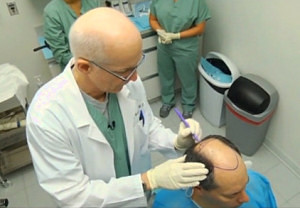 Dr. Bernstein drawing a hair transplant design
Dr. Bernstein drawing a hair transplant designIn 1997, Dr. Bernstein published a seminal paper, “The Aesthetics of Follicular Transplantation,” in the journal Dermatologic Surgery. This paper defined for the hair transplant industry a series of judgments that a surgeon must make to determine the best aesthetic outcome for a patient.
These judgments include how best to distribute a limited amount of donor hair, how to design the hairline, and when and how to restore the crown area. Each decision must be made for each patient based on their short- and long-term hair restoration needs.
The “art” of the hair transplant is to strike the right balance between simply achieving “coverage” and producing a pattern that is recognized as being natural.
The Aesthetics of Follicular Transplantation, Dermatologic Surgery (1997), p. 790.
Limited Donor Hair Supply
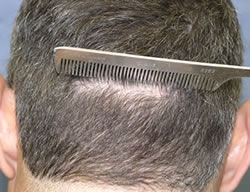 Donor area in back of scalp
Donor area in back of scalpThe donor area is the zone in the back and sides of the scalp where hair is genetically resistant to dihydrotestosterone (DHT), the hormone that causes hair loss. These DHT-resistant follicles are the units that are transplanted in surgical hair restoration.
A key limitation of hair transplant surgery is the finite number of these follicles in a person’s scalp. There will never be enough donor hair to completely replace all of one’s lost hair, especially in cases of extensive balding. This is true regardless of the type of hair transplant procedure that is used.
Thus, the principal question faced by hair transplant surgeons is how best to distribute the limited supply of donor hair to balding areas of the scalp.
 Close-up of scalp showing different size follicular units
Close-up of scalp showing different size follicular unitsEach square millimeter (mm2) of the scalp normally contains, on average, just slightly less than one follicular unit, which itself contains from 1 to 4 hair follicles (or an average of 2.2 hairs/follicular unit). So, the average density of a typical non-bald scalp is about 2 hairs/mm2.
The donor area contains about 25% of a person’s total scalp hair, however, only about half of the donor supply (12.5% of total hair) can be harvested without the thinning becoming noticeable. If all the available donor hair (12.5% of total hair) was used to uniformly cover an area six times larger (the 75% of the scalp that is susceptible to balding), the resulting density would be at most 1/6th the original density of 2 hairs/mm2, or 0.33 hairs/mm2.
While uniform coverage of 0.33 hairs/mm2 would improve the appearance of a patient with extensive balding, a hair restoration surgeon can create an even more aesthetically pleasing look by adjusting the distribution of that hair — i.e., by increasing it in some areas and decreasing it in others.
In the next section, we illustrate how a natural-looking hair transplant design is made possible by the aesthetic distribution of follicular units.
Aesthetic Distribution of Follicular Units
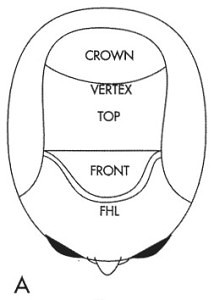 Regions of the balding scalp
Regions of the balding scalp
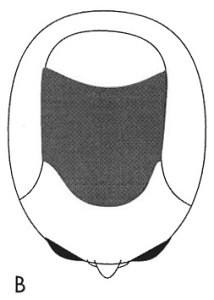 Even distribution of sites in the front and top/vertex
Even distribution of sites in the front and top/vertex
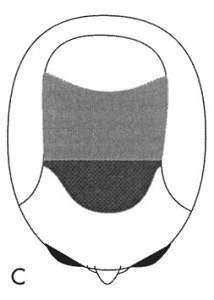 “Forward weighting” of sites
“Forward weighting” of sites
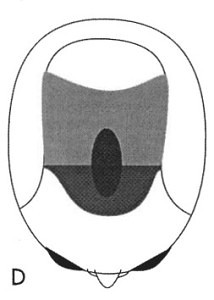 Central concentration of larger follicular units superimposed upon forward weighting
Central concentration of larger follicular units superimposed upon forward weighting
In order to plan the distribution of a limited number of follicular units for the greatest cosmetic impact, the balding area is divided into three regions (see Figure A):
- frontal hairline (FHL) and front of the scalp
- mid-scalp (formerly called the top or vertex)
- vertex/crown
A typical scalp has a density of about 2 hairs/mm2, but we can lose up to half of that before it becomes noticeable. Therefore, the ideal post-transplant density in the cosmetically most important area of the scalp should be about 1 hair/mm2. Anything more would be a waste of effort and follicular units.
Below are a few scenarios for a typical Norwood Class VI patient who requires 2,500 follicular units to cover the front and top of the scalp, plus the aesthetic considerations behind each scenario.
Example 1: Uniform Distribution
If 2,500 follicular units, containing a total of 5,000 hairs, were uniformly distributed over the 20,000 mm2 of the front and top of the scalp (see Figure B), the resulting density would be 0.25 hairs/mm2. As discussed above, this is more aesthetically pleasing than an extensively bald scalp, but it is still well short of the ideal post-transplant density of 1 hair/mm2.
Example 2: Forward Weighting
Since people are viewed from the front or at a ¾ angle, the surgeon can use this aesthetic consideration to enhance the hair restoration design. By “forward weighting” the distribution of follicular units (see Figure C), the aesthetic result of the hair transplant will be increased fullness in the front compared to uniformly distributed follicles.
In this example, we place 1,000 follicular units, or 2,000 hairs, into the frontal region (5,000 mm2) for a density of 0.4 hairs/mm2. The remaining 1,500 follicular units (or 3,000 hairs) would then be placed into the mid-scalp region (15,000 mm2) for a density of 0.2 hairs/mm2.
By using the “forward weighting” technique, the front is now twice as dense as the mid-scalp and the overall appearance of the patient is dominated by the frontal view.
Example 3: Enhanced Forward Weighting
We can further improve upon a “forward weighting” distribution with “enhanced forward weighting.” In this technique, the surgeon places larger follicular units in the mid-portion of the frontal scalp (see the black oval in Figure D). This “forelock” type of distribution will add even more fullness to this most cosmetically-important part of the scalp.
These three examples illustrate how the physician can distribute limited donor hair to the balding areas in a way that provides the best aesthetic outcome for the hair transplant.
Restoring the Frontal Hairline
One of the most important aspects of hair restoration surgery is the creation, or restoration, of the frontal hairline. Before the advent of follicular unit transplant procedures, physicians would often create a row of large-graft “plugs” at the frontal hairline. Compared to today’s procedures, these hair transplants seem almost barbarically unnatural.
There are three main reasons why these “pluggy” procedures are so displeasing to the eye:
- natural hairlines start with small, 1-hair follicular units, not large clumps of hair
- natural hairlines are irregular, follicular units do not appear in a straight line
- a natural hairline in a mature individual begins a bit higher up on the forehead compared to where a young person’s hairline begins.
As in other aspects of the transplant, the key to establishing a natural looking transition zone is to mimic as closely as possible the one that occurs in nature.
The Aesthetics of Follicular Transplantation, Dermatologic Surgery (1997), p. 788.
A modern hair transplant surgeon can use original methods described by Dr. Bernstein to better match the look of one’s natural hair.
Follicular Unit Size & Spacing
Normal frontal hairlines are not characterized by a solid line of hair, but by follicular units of increasing size and proximity. The smallest units naturally occur at the very front of the hairline, and so the best way to reconstruct a natural frontal hairline is to mimic what occurs naturally: place single-hair units into the frontal edge, followed by two-, three-, and possibly four-hair units behind them.
Symmetry
While “beauty” in living organisms is often defined by symmetry in anatomical features, the frontal hairline is naturally irregular. The surgeon must take care to enhance the patient’s appearance with the proper balance between symmetry and irregularity. This can be achieved by placing about 100 one-hair follicular units in varyingly shaped triangles in front of a symmetrical band of staggered one-hair units one to three rows deep.
Mature Hairline Position
 Designing a hairline and whorl
Designing a hairline and whorlThe typical adolescent hairline recedes to a mature position as we age. For patients who have lost their mature hairline, the goal – with few exceptions – is to recreate the hairline at its normal mature position and not the low hairline a person might have had in their early 20s. Recreating this mature hairline will help frame the face and maximize the cosmetic value of the transplant while avoiding an unnaturally low hairline.
It is particularly important to explain the aesthetic considerations to young patients, who often seek to re-establish their receding adolescent hairline and might find that a mature hairline does not meet their expectations. It is crucial for younger patients to know that a hair transplant is not always designed for immediate gratification, but is a permanent surgical procedure that must be viewed through a long-term aesthetic lens. Transplanting the frontal hairline too low could create problems that persist for many years or, at worst, require reparative surgery.
We feel that establishing the frontal hairline in the correct position is the single most important function of the first hair transplant procedure.
The Aesthetics of Follicular Transplantation, Dermatologic Surgery (1997), p. 791.
Recipient Sites & Hair Direction
One of the more intricate aspects of hair transplant surgery is the creation of recipient sites, tiny holes created in the scalp into which follicular unit grafts are placed. What makes them so important is that the way these holes are created determines the direction the hair points as it grows out of the scalp and the angle of elevation of the hair to the skin.
A common mistake a hair transplant surgeon can make is placing grafts perpendicular to the scalp or in the direction that the patient plans to groom their hair. In the first case, the resultant hairs would appear wild and be “ungroomable.” In the second case, the hairs would lie flat and lack the natural “bowed” appearance created when styled or combed against the position it would normally grow. It is this bowing that contributes to the fullness of a properly performed hair transplant. The correct aesthetic choice is to create recipient sites in such a way that the hairs grow out of the skin at the angle and direction they originally grew before the transplant.
Interestingly, 18 years after the publication of his original paper, Dr. Bernstein is working with Restoration Robotics to enable the ARTAS Robot to create recipient sites using these basic principles.
Racial Considerations in Hair Transplant Design
Because there are so many racial and ethnic elements that affect the aesthetics of coverage, the surgeon should have great familiarity with the normal hair patterns and characteristics specific to each group before attempting a transplant.
The Aesthetics of Follicular Transplantation, Dermatologic Surgery (1997), p. 795.
When we look at Caucasian, Asian, and African patients we see differences in follicular unit density (units/mm2), hair density (hairs/mm2), and the predominant grouping of hairs (see Table 1). These characteristics mandate differences in the hair transplant design for these patients.
There is little difference between transplanting Asian and Caucasian hair. The exception is when an Asian patient has coarse and straight hair with light skin. In this case, the surgeon should use more single-hair follicular units in the transition zones from the totally bald part of the scalp into the thicker parts of the hair transplant.
Additionally, while the coarse straight hair gives the surgeon the advantage of achieving more bulk in the front part of the scalp, it is critical to remember that the Asian scalp tends to have a relatively lower donor density than the Caucasian scalp. Therefore, the physician must be careful not to place too many follicular units in the front of the scalp, as this will leave fewer units for other areas.
Transplanting African Hair
African scalps tend to have a low average density. This might seem like a limitation for hair transplant surgery, however, this factor is more than offset by a predominance of three-hair follicular units. In fact, this relatively high average hair grouping can create some of the best cosmetic results.
Since the follicular units of African hair tend to be larger and more curved than in Caucasian or Asian hair, extra care must be taken during dissection and extraction to avoid damaging the grafts.
Additionally, the larger follicular units also require larger recipient site incisions, and so the sites must be spaced further apart compared to sites created in Caucasian or Asian scalps.
Conclusion
In sum, hair transplant design requires making important judgments determined by the characteristics of the individual patient. The goal is simply to maximize the use of a limited supply of donor hair to most accurately mimic the way hair grows in nature and achieve the best aesthetic result.
 Follow the progress of a patient from planning the surgery to the maturation of the results in our Hair Transplant Photo Journal. See how a patient looks before the transplant, during the procedure, in the post-operative period, and in the weeks and months following as his transplanted hair grows. >>
Follow the progress of a patient from planning the surgery to the maturation of the results in our Hair Transplant Photo Journal. See how a patient looks before the transplant, during the procedure, in the post-operative period, and in the weeks and months following as his transplanted hair grows. >>




